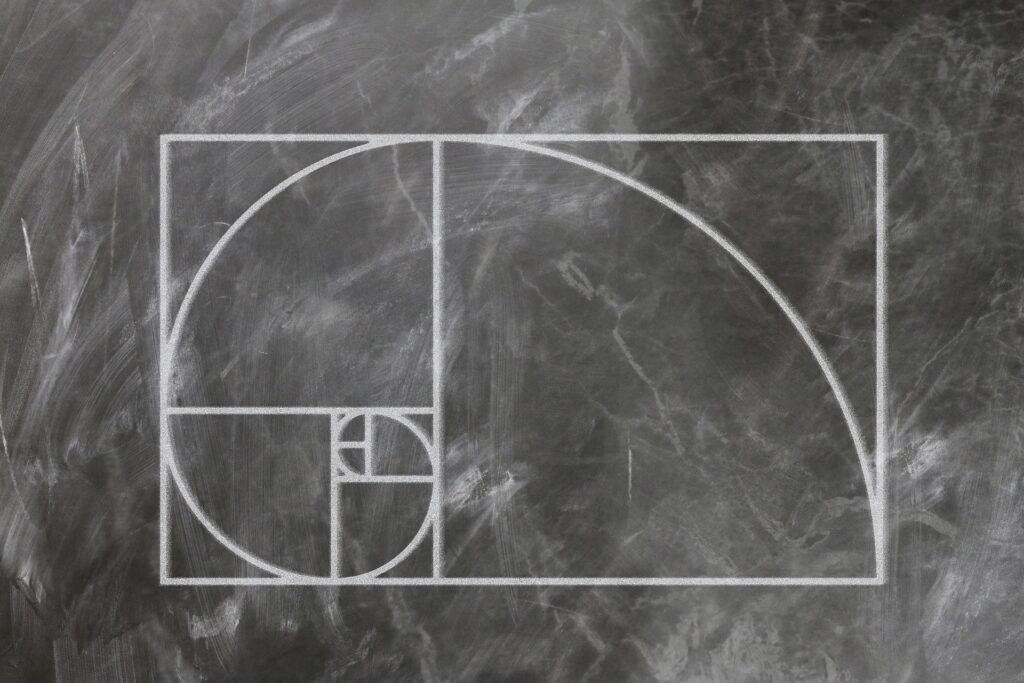History and Origin of the Golden Ratio
The golden ratio is a proportional relationship known since antiquity and widely used in visual arts. The first recorded definition dates back to Euclid of Alexandria in the 3rd century BC. He described the division of a line into two unequal segments where the ratio of the larger segment to the whole line equals the ratio of the larger segment to the smaller one.
Ancient Origins
Despite being defined in ancient times, there are few surviving written notes or construction drawings proving its practical application in ancient buildings or paintings. In most cases, the golden ratio was discovered retrospectively in ancient artworks. One such example is the famous statue of Venus de Milo from the 2nd century BC, which exhibits proportions based on the golden ratio.
Fibonacci Sequence and Approximation to Phi
In 1202, mathematician Leonardo Fibonacci described a sequence of numbers that progressively approaches the value of Phi, the golden ratio (approximately 1.618). This Fibonacci sequence starts with 1, 1, and each subsequent number is the sum of the two preceding numbers (1, 1, 2, 3, 5, 8, 13, …). As the sums increase, the ratio between consecutive numbers approaches the golden ratio more closely.
Renaissance Spread
During the Renaissance, the golden ratio regained prominence. The Franciscan friar Luca Pacioli, who taught at the University of Perugia, extensively studied this proportion and first referred to it as “divina proportio” (divine proportion). This term was derived from Plato’s identification of creation with the five Platonic solids, for which the golden ratio was an essential construction tool.

Mathematical Foundations of the Golden Ratio
The golden ratio is based on a specific division ratio. A line segment is divided into two unequal parts such that the ratio of the longer segment (a) to the entire length (a+b) equals the ratio of the longer segment (a) to the shorter segment (b). This proportion can be expressed with the formula (a+b)/a = a/b.
The Golden Number Phi
The number describing this division ratio is denoted by the Greek letter Phi (Φ) and has a value of 1.618… It is an irrational number that cannot be precisely represented as the ratio of two integers. The first few decimal places are:
Φ = 1,618 03 39887 49894 84820 45868 34365 63811 77203 09179 80576…
As of February 2021, even 10 trillion decimal places of Phi have been calculated and verified.
Fibonacci Sequence and Approximation to Phi
The Fibonacci sequence (1, 1, 2, 3, 5, 8, 13, 21, 34, 55…) increasingly approximates the value of Phi as the numbers grow larger.
The formula for calculating the terms of the Fibonacci sequence is:
fn = (Φn – (-1/Φ)n) / √5
Due to its close connection to the Fibonacci sequence, Phi can be represented as the limit of the ratios of consecutive Fibonacci numbers.
The Golden Ratio in Practice
Use of the Camera Grid
Almost all modern cameras offer the option to display a grid or overlay on the screen. This helps align the composition of the image according to the rules of the Golden Ratio. Although this grid typically consists of nine equally sized squares, the intersections are very close to the ideal positions of the Golden Ratio.
So, activate the grid in the camera settings. Position your main subject at one of the four intersections, which are slightly closer to the center of the image. This asymmetric placement creates a harmonious, balanced image following the principles of the Golden Ratio.
Initially, working with the grid can be helpful to develop a sense of optimal image division. Later on, you can hide it and intuitively compose your shots using the Golden Ratio.
Application in Various Shooting Situations
The Golden Ratio is excellent for many areas of photography:
- Portrait Photography: Place the subject’s head at one of the intersections instead of centering it. This adds more dynamics and tension to the image.
- Landscape Photography: Roughly divide the scenery into one-third sky and two-thirds landscape. Position prominent elements like mountain peaks or trees at the intersections.
- Nature Photography: Compose flowers, animals, or other natural subjects along the lines of the Golden Ratio for a harmonious effect.
- Still Life: Arrange the objects of a still life deliberately at the intersections to direct the viewer’s attention.
Leave some space in the frame while photographing so you can optimize the composition according to the Golden Ratio during post-processing. In programs like Photoshop, you can overlay the grid on your image afterward and adjust the cropping accordingly.
Photography
Comparison with the Rule of Thirds
The Rule of Thirds and the Golden Ratio share some similarities but differ significantly from each other. Both concepts serve the purpose of harmonious composition by dividing the image area into sections and providing focal points for placing the main subject.
Similarities and Differences:
- Similarities:
- Division of the image into three rows and three columns
- Four focal points with strong attention focus
- Create harmony in the composition
- Generate tension in the relationship between the main subject and negative space
- Differences:
- The Rule of Thirds:
- Primarily applied in photography
- Divides the image into nine equally sized rectangles
- Much simpler to apply in practice
- Has a purely “human” background
- The Golden Ratio:
- Has fascinated mathematics for over 2,500 years (long tradition)
- Specifies a harmonious division ratio of a line segment
- Found in nature without human influence
- Ratio is applied in many fields beyond photography
- Known and recognized in various cultural contexts as an expression of harmony
- The Rule of Thirds:
When to Apply Which Rule
In general, you can hardly go wrong with the Rule of Thirds. Approximately 98% of all photos benefit from this rule. However, there are subjects where the Rule of Thirds is obstructive, especially where symmetry is involved, such as reflections or architectural photography.
On the other hand, the Golden Ratio is best used in post-processing. If you feel that the motif underscores your image statement with harmony or contrasts with it, or simply because your photo looks more appealing with the Golden Ratio. The Golden Ratio stands for harmony and tranquility, while the Rule of Thirds creates tension and attention. Choose which design tool best suits your image.
Conclusion
In summary, the Golden Ratio provides a powerful tool for creating harmonious and balanced image compositions in photography. By strategically placing the main subject at the intersections of the Golden Ratio, you can effectively direct the viewer’s focus and create an appealing relationship between the subject and negative space. Whether in portrait, landscape, or nature photography, the application of this proportion admired since antiquity can impart a sense of aesthetics and balance to your photos.
While the Rule of Thirds serves as a solid guide for balanced compositions in many situations, the somewhat more complex Golden Ratio can excel where special harmony and tranquility are required. By mastering the mathematical foundations and practical applications of the Golden Ratio, you expand your creative possibilities as a photographer and tap into another level of image composition.








